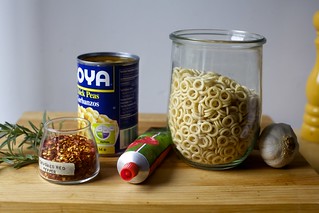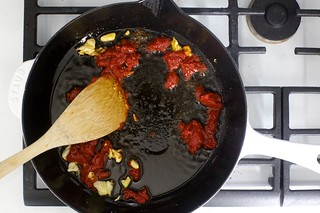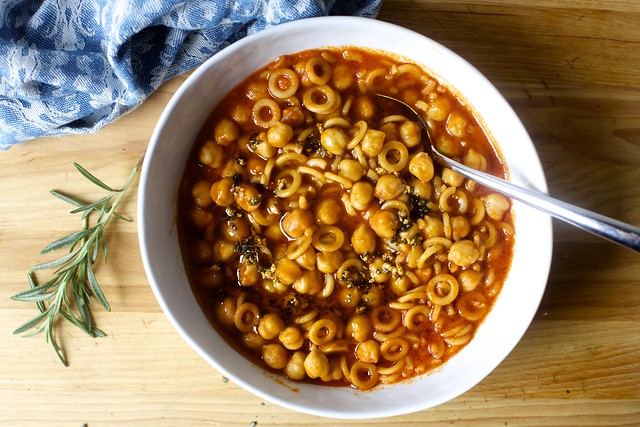Pasta e ceci (pasta and chickpeas) is one of Rome’s most iconic dishes, the only dish so essential that it shows up on both Tuesdays and Fridays on the informal meal calendar.* And while there are no two matching ways to make it (a fine excuse to spend as many weeks in Rome as it takes to try them all, if you ask me), the rough guiding recipe principles are fairly consistent: a sautéed base of garlic, sometimes onion, celery and carrot too, and seasonings to which chickpeas, water or chickpea cooking broth, and pasta are added. Some are a more brothy like soup, some blend some chickpeas for a thicker base, some more herby with rosemary or sage, some are light and others are heavy on tomatoes. And then then came Victoria Granof’s version that took the internet by storm over the last couple years as word of it trickled out from her Chickpeas cookbook (which goes so far beyond hummus in ways that only a Le Cordon Bleu-trained chef and famous food stylist would think of) in the lovely Short Stack single ingredient cookbook series.


I bet you think this means it will be complicated. It is, in fact, the opposite. Granof’s version has 5 ingredients, I bet every single one is in your pantry right now, and takes 20 minutes, which is why there’s no making it just once. We all need more 20-minute dinner magic in our lives, so it’s not surprising that it’s already made the web rounds from Food52 to Dinner: A Love Story.


It could also be argued that there’s little I can add to it: why mess with perfection? But I found two little things along the way: The first is that the first time I decided I wanted to make it (you know, 5 minutes after reading about it; this recipe has that effect on people) I discovered that I didn’t have any small pasta around except for little rings familiar to anyone who ate or wish they got to eat (me!) Spaghetti-Os growing up, the little Os are an official pasta shape called annellini. Did I originally buy them with vague aspirations of reverse engineering the canned stuff? You betcha. But after I saw how quickly my children gobbled this similar-looking dish up (and it’s so great in a thermos for lunch too, so go ahead and double it), I am glad I hadn’t gotten to it yet.


The second thing is a little extra finish that I do when I have a minute or two more to spare. Rather than just drizzling olive oil on top, as is traditional, I love to heat it with some additional chopped garlic, minced rosemary leaves, salt and pepper flakes for a minute for a nutty, flavorful, slightly crispy, and dramatically sizzling finish, and alternative to the usual parmesan or pecorino, which is not unwelcome here, just not nearly as dynamic.
* Please note: 80% of what I know about Roman cooking, and particularly pasta e ceci, I’ve learned from the fantastic Rachel Roddy; please do not miss her Guardian column, blog, or books but be warned you might buy tickets to Rome five minutes later, which is essentially what we did in 2013. (The other 10% is from non-Roddy Roman food writers and the remaining 10% was gleaned on that vacation.)

Quick Pasta and Chickpeas / Pasta e Ceci
- 2 tablespoons olive oil
- 2 cloves garlic, peeled and smashed
- 3 tablespoons tomato paste
- 1 teaspoon kosher salt, plus more to taste
- Freshly ground black pepper or red pepper flakes, to taste
- 1 1/2 cups cooked chickpeas (from one 15-ounce can, drained and rinsed)
- 1/2 cup (2 ounces or 55 grams) uncooked ditalini pasta (or another small shape; I use annelini)
- 2 cups (275 ml) boiling water
-
To finish
- 2 to 3 tablespoons olive oil (estimate 1 per serving)
- 1 clove of garlic, peeled and finely chopped
- 1 teaspoon minced fresh rosemary
- Salt and red pepper flakes
Make finishing oil: Heat 2 to 3 tablespoons olive oil in a small sauce- or frying pan over medium-low heat with remaining clove of garlic, rosemary, a pinch or two of salt and pepper flakes, until sizzling; pull it off the heat as soon as the garlic is going to start taking on color. Drizzle this over bowls of pasta e ceci and eat it right away.
Source: http://feedproxy.google.com/~r/smittenkitchen/~3/C1haiPr3e9M/